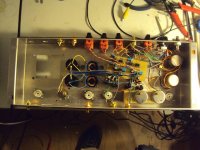First is a good subsonic filter that makes the response in the bass flat. Of cause it would be better when cart and arm are well matched and there would be some kind of fluid damping. Fluid damping has of cause other problems that can effect resolution in the mid and treble when it is overdone. I have experience with the Spiral Grove Centroid, the Well Tempered Amadeus and the Triplanar. In all cases the damping, when used in moderation gives a market improvement in clarity and stability of sound. The subsonic filter is of cause only a band aid because it does not work on the physical cause but adding my TD ( time domain ) subsonic filter to the Centroid gave an additional improvement, even when the paddle was sunk into the fluid, so i think we need both : mechanical plus electrical damping. I have demonstrated that filter on CES successfully. By coincidence John Curl was in the room too and i opened the box for him him, showing the circuit and we even had a small chat. On the other side of the spectrum i use an input transformer. That transformer has a switchable Zobel at the output that optimizes treble response to a certain cartridge. In my case i use a Lyra Titan i and the response of the cartridge plus transformer is flat to over 50kHz. I also have "tone controls" that can change EQ in the bass from 1000 to 6000usec and in the treble from 10usec to 110usec. I also have a bass boost and a treble boost switch. The graph shows what the "tone controls" do. They also can be used to copy other EQs then RIAA if adjusted properly. In my line stage i have a balance control and a mono switch. I think that is necessary too. The balance control is set up in such a way, so that the total volume does not change when i change balance. You see, i am not your typical bare bones audiophile but i trust a system approach, where all components are matched.
That of cause does not allow simple swapping of components without consequences.
That of cause does not allow simple swapping of components without consequences.
Attachments
"If the electrical response exactly compensates for the mechanical response then there will be no ringing, because this will be compensated too. "
DF96,
The nonlinearities don't subtract, they add. The cartridge mechanical response looks overdamped but it will not cancel the underdamped response of the electrical circuit. You will still have overshoot and ringing.
DF96,
The nonlinearities don't subtract, they add. The cartridge mechanical response looks overdamped but it will not cancel the underdamped response of the electrical circuit. You will still have overshoot and ringing.
I wasn't talking about nonlinearities. Neither, I suspect, are you. Ringing is not caused by nonlinearity. If two filters are cascaded then their combined response may avoid ringing even if one of them rings on its own. Just ordinary filter theory.The nonlinearities don't subtract, they add. The cartridge mechanical response looks overdamped but it will not cancel the underdamped response of the electrical circuit. You will still have overshoot and ringing.
The only circuit that I've personally seen that used an input buffer was the jfet srpp phono preamp detailed in Elektor magazine. Since that circuit used a high capacitance jfet in the initial srpp stage (with resulting amplified Miller capacitance) putting a buffer in front of it made a perverse sort of sense. Using a jfet with lower capacitance in the first place would have made more sense.
The SRPP JFET Elektor circuit had voltage gain, so can't really called a buffer.
- Status
- Not open for further replies.
